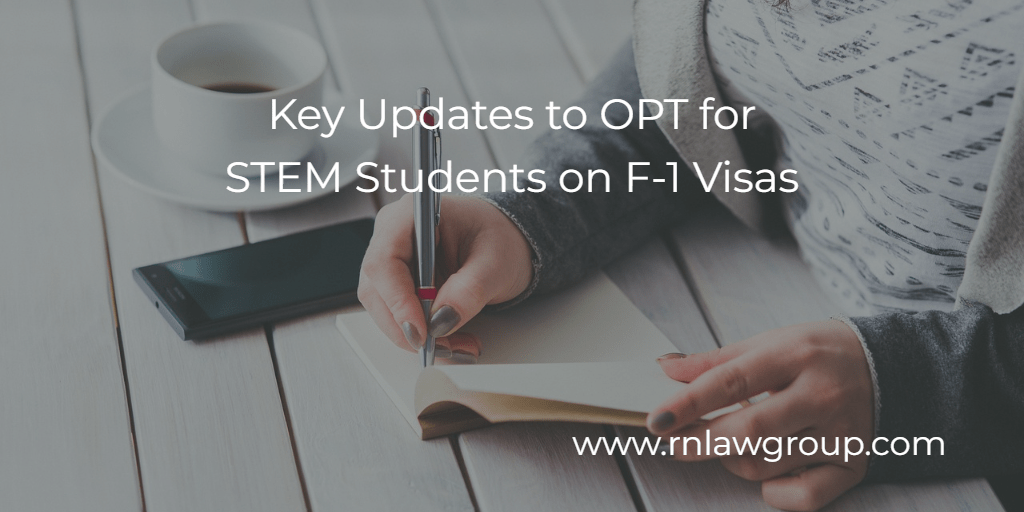
Key Updates to OPT for STEM Students on F-1 Visas
On August 27, 2024, the U.S. Citizenship and Immigration Services (USCIS) issued a new policy alert (PA-2024-22) concerning Optional Practical Training (OPT) for students on F-1 visas who are studying in Science, Technology, Engineering, and Mathematics (STEM) fields. This article aims to explain the key points of this policy update to understand how these changes might affect F-1 visa holders.
What is Optional Practical Training (OPT)?
OPT is a type of employment authorization that allows F-1 visa holders—international students studying in the United States—to work in jobs related to their field of study. There are two types of OPT:
- Pre-completion OPT: Work authorization that can be used while the student is still pursuing their degree.
- Post-completion OPT: Work authorization that begins after the student has completed their degree.
Students in Science, Technology, Engineering, and Mathematics (STEM) fields can apply for a 24-month extension of their post-completion OPT, giving them up to three years to gain practical work experience in the U.S.
Key Updates from the August 2024 Policy Alert
The recent policy update introduces several important changes and clarifications regarding OPT for STEM students. Below are the most notable aspects of the update:
- Online and Distance Learning Courses:
- The new policy clarifies that F-1 students can count one online class or up to three online credits per term towards their full course of study requirement. This means that students are allowed to include a limited amount of online or distance education as part of their studies without violating the terms of their visa.
- School Transfers:
- The policy explains that F-1 students can transfer between schools that are certified by the Student and Exchange Visitor Program (SEVP). This applies whether the transfer is within the same educational level (like transferring from one bachelor’s program to another) or to a different level (such as moving from a bachelor’s program to a master’s program).
- Grace Period After OPT:
- After finishing their post-completion OPT, F-1 students have a 60-day grace period. During this time, they can prepare to leave the U.S., transfer to another SEVP-certified school, or apply to change their visa status.
- Eligibility for Post-Completion OPT:
- The policy clarifies that F-1 students are eligible for post-completion OPT not only after completing a bachelor’s, master’s, or doctoral degree but also after completing an associate’s degree program. This is particularly significant for students who have earned an associate’s degree in a STEM field, as they may now qualify for post-completion OPT.
- STEM OPT Extension Application Period:
- The policy corrects the time period during which students can apply for the 24-month STEM OPT extension. It’s essential for students to be aware of the correct timeframe to avoid missing their opportunity to apply. F-1 students may submit a properly filed Form I-765 up to 90 days before the expiration of the F-1 student’s current post-completion OPT EAD and no more than 30 days after their DSO enters the STEM OPT recommendation into SEVIS.
- Study Abroad and SEVIS Status:
- If an F-1 student is enrolled in a SEVP-certified school and participates in a study abroad program that lasts less than five months, they can remain active in the Student and Exchange Visitor Information System (SEVIS). However, if the study abroad program exceeds five months, the student will need a new Form I-20 (a document issued by the school that verifies the student’s eligibility to study in the U.S.) when they return.
What Does This Mean for F-1 Students in STEM Fields?
These updates offer more flexibility and clarity for F-1 students, particularly those in STEM fields. Here’s how these changes might impact students:
- Flexibility with Online Courses: F-1 students can continue to incorporate a limited amount of online learning into their studies without risking their visa status. This is especially useful for students who need to take certain courses online due to scheduling conflicts or personal preferences.
- Simplified School Transfers: The ability to transfer between SEVP-certified schools without issues means that students have more freedom to change schools if they find a better program or if they want to continue their education at a higher level.
- 60-Day Grace Period: The 60-day grace period after OPT gives students more time to figure out their next steps, whether it’s continuing their education, changing their visa status, or preparing to return to their home country.
- Broader Eligibility for OPT: Including associate’s degrees in the eligibility criteria for post-completion OPT opens up opportunities for students who have completed shorter, focused programs in STEM fields to gain valuable work experience in the U.S.
- Correct Timing for STEM OPT Applications: Knowing the correct time to apply for the STEM OPT extension is crucial. Missing this window could result in losing the chance to extend your work authorization, so it’s important to stay informed about deadlines.
- Continued SEVIS Status During Study Abroad: Students participating in short-term study abroad programs can maintain their SEVIS status, which simplifies the process of returning to the U.S. after their program ends.
Why This Policy Update Matters
Understanding these updates is crucial for F-1 students in STEM fields because it affects their ability to legally work in the U.S. and plan their academic and professional futures. The changes provide more options and greater clarity, making it easier for students to navigate the complex rules surrounding their visa status.
For example, the clarification about online courses might make it easier for students to balance their studies with work or other commitments. The ability to transfer schools without hassle can help students find the best educational fit, while the 60-day grace period offers more time to make important decisions after graduation.
Final Thoughts
The August 2024 policy update from USCIS introduces significant changes to the rules governing OPT for F-1 students, particularly those in STEM fields. By providing clearer guidelines on online learning, school transfers, and post-OPT options, the update helps F-1 students make informed decisions about their education and career paths in the U.S.
For students currently on an F-1 visa or those considering studying in the U.S., it’s essential to stay informed about these changes and understand how they may affect your plans. If you’re unsure about any aspect of the new policy, consider reaching out to an immigration advisor at your school or an experience immigration lawyer.
By: Felipe Jimenez
Felipe Jimenez is an Associate Attorney at Reddy & Neumann, P.C. He works in the Non-Immigrant Visa (NIV) Department where he assists clients through all phases of the non-immigrant visa process.
Reddy & Neumann, P.C. has been serving the business community for over 20 years and is Houston’s largest immigration law firm focused solely on US. Employment-based immigration. We work with both employers and their employees, helping them navigate the immigration process quickly and cost-effectively.

